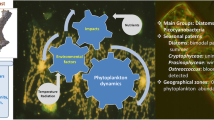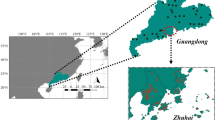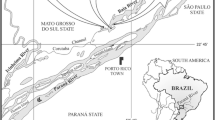Abstract
This article summarizes the outcomes of the 16th Workshop of the International Association for Phytoplankton Taxonomy and Ecology. Four major issues dealing with the impact exerted by human activities on phytoplankton were addressed in the articles of this special volume: climate change and its impacts on phytoplankton, the role of land use in shaping composition and diversity of phytoplankton, the importance of autecological studies to fully understand how phytoplankton is impacted by stressors and the role of ecological classification to evaluate community changes due to the different impacts. Case studies from different types of aquatic environments (rivers, deep and shallow lakes, reservoirs, mountain lakes, and temporary ponds) and from diverse geographical locations (not only from the Mediterranean and temperate regions, but also from subtropical and tropical ones) have shown that a complex spectrum of human impacts, not exclusively linked to eutrophication, severely conditions structure and dynamics of phytoplankton assemblage both in the short and long terms. Moreover, the trade-offs between climate change and other human-induced stresses as eutrophication, agricultural and urban land use or water overexploitation contribute to make more severe the impact exerted by humans on phytoplankton and, in turn, on the functioning of aquatic ecosystems.
Similar content being viewed by others
References
Abonyi, A., M. Leitão, A. M. Lançon & J. Padisák, this volume. Phytoplankton functional groups as indicators of human impacts along the River Loire (France). Hydrobiologia. doi:10.1007/s10750-012-1130-0.
Alvarez Cobelas, M., C. Rojo & D. Angeler, 2005. Mediterranean limnology: current status, gaps and the future. Journal of Limnology 64: 13–29.
Borics, D., G. Várbíró, I. Grigorszky, E. Krasznai, S. Szabó & K. T. Kiss, 2007. A new evaluation technique of potamoplankton for assessment the ecological status of rivers. Archiv für Hydrobiologie, Supplement Large Rivers 161: 465–486.
Borics, G., B. Tóthmérész, B. A. Lukács & G. Várbíró, this volume. Functional groups of phytoplankton shaping diversity of shallow lake ecosystems. Hydrobiologia. doi:10.1007/s10750-012-1129-6.
Boyce, D. G., M. R. Lewis & B. Worm, 2010. Global phytoplankton decline over past century. Nature 466: 591–596.
Carraro, E., N. Guyennon, D. Hamilton, L. Valsecchi, E. C. Manfredi, G. Viviano, F. Salerno, G. Tartari & D. Copetti, 2012. Coupling high-resolution measurements to a three-dimensional lake model to assess the spatial and temporal dynamics of the cyanobacterium Planktothrix rubescens in a medium-sized lake. Hydrobiologia. doi:10.1007/s10750-012-1096-y.
Dokulil, M. & K. Teubner, this volume. Deep living Planktothrix rubescens modulated by environmental constraints and climate forcing. Hydrobiologia. doi:10.1007/s10750-012-1020-5.
Dokulil, M. T., A. Jagsch, G. D. George, O. Anneville, T. Jankowsky, B. Wahl, B. Lenhart, T. Blenckner & K. Teubner, 2006. Twenty years of spatially coherent deepwater warming in lakes across Europe related to the North Atlantic Oscillation. Limnology and Oceanography 51: 2787–2793.
Elliott, J. A., I. D. Jones & S. J. Thackeray, 2006. Testing the sensitivity of phytoplankton communities to changes in water temperature and nutrient load, in a temperate lake. Hydrobiologia 559: 401–411.
European Parliament and Council, 2000. Directive 2000/60/EC of the European Parliament and of the Council of 23 October 2000 Establishing a Framework for Community Action in the Field of Water Policy, PE-CONC 3639/1/00, REV 1, ENV 221, CODEC 513, Brussels: 152 pp.
Field, C. B., M. J. Behrenfeld, J. T. Randerson & P. Falkowski, 1998. Primary production of the biosphere: integrating terrestrial and oceanic components. Science 281: 237–242.
Flaim, G., U. Obertegger & G. Guella, this volume. Changes in galactolipid composition of the cold freshwater dinoflagellate Borghiella dodgei in response to temperature. Hydrobiologia. doi:10.1007/s10750-012-1070-8.
George, G. (ed.), 2010. The Impact of Climate Change on European Lakes. Springer, Dordrecht.
Goldman, C. R., A. D. Jassby & T. Powell, 1989. Interannual fluctuations in primary production: meteorological forcing at two subalpine lakes. Limnology and Oceanography 34: 310–323.
Harper, D. M. & W. D. P. Stewart, 1987. The effects of land use upon water chemistry, particularly nutrient enrichment, in shallow lowland lakes: comparative studies of three lochs in Scotland. Hydrobiologia 148: 211–229.
Hoffman, M. D. & S. I. Dodson, 2005. Land use, primary productivity, and lake area as descriptors of zooplankton diversity. Ecology 86: 255–261.
Izaguirre, I., L. Allende, R. Escaray, J. Bustingorry, G. Pérez & G. Tell, this volume. Comparison of morpho-functional phytoplankton classifications in human-impacted shallow lakes with different stable states. Hydrobiologia. doi:10.1007/s10750-012-1069-1.
Jöhnk, K. D., J. Huisman, J. Sharples, B. Sommeijer, P. M. Visser & J. M. Stroom, 2008. Summer heatwaves promote blooms of harmful cyanobacteria. Global Change Biology 14: 495–512.
Kaiblinger, C., O. Anneville, R. Tadonleke, F. Rimet, J. C. Druart, J. Guillard & M. T. Dokulil, 2009. Central European water quality indices applied to long-term data from peri-alpine lakes: test and possible improvements. Hydrobiologia 633: 67–74.
Katsiapi, M., A. D. Mazaris, E. Charalampous & M. Moustaka-Gouni, this volume. Watershed land use types as drivers of freshwater phytoplankton structure. Hydrobiologia. doi:10.1007/s10750-012-1095-z.
Keller, W., 2007. Implications of climate warming for Boreal Shield lakes: a review and synthesis. Environmental Review 15: 99–112.
Kruk, C. & A. M. Segura, this volume. The habitat template of morphology-based functional groups. Hydrobiologia. doi:10.1007/s10750-012-1072-6.
Kruk, C., V. L. M. Huszar, E. T. H. M. Peeters, S. Bonilla, L. Costa, M. Lürling, C. S. Reynolds & M. Scheffler, 2010. A morphological classification capturing functional variation in phytoplankton. Freshwater Biology 55: 614–627.
Kruk, C., E. T. H. M. Peeters, E. H. van Nes, V. L. M. Huszar, L. S. Costa & M. Scheffler, 2011. Phytoplankton community structure can be predicted best in terms of morphological groups. Limnology and Oceanography 56: 110–118.
Longhurst, A., S. Sathyendranath, T. Platt & C. Caverhill, 1995. An estimate of global primary production in the ocean from satellite radiometer data. Journal of Plankton Research 17: 1245–1271.
Matzinger, A., M. Schmid, E. Veljanoska-Sarafiloska, S. Patcheva, D. Guseska, B. Wagner, B. Müller, M. Sturm & A. Wüest, 2007. Eutrophication of ancient Lake Ohrid: global warming amplifies detrimental effects of increased nutrient inputs. Limnology and Oceanography 52: 338–353.
McQuatters-Gollop, A., P. C. Reid, M. Edwards, P. H. Burkill, C. Castellani, S. Batten, W. Gieskes, D. Beare, R. R. Bidigare, E. Head, R. Johnson, M. Kahru, J. A. Koslow & A. Pena, 2011. Is there a decline in marine phytoplankton? Nature 472: E6–E7.
Mischke, U., B. Nixdorf, E. Hohn & U. Riedmüller, 2002. Möglichkeiten zu Bewertung von Seen anhand des Phytoplanktons. Aktueller Stand in Deutschland. Aktuelle Reihe %/02: 25-37, BTU, Cottbus.
Morabito, G., A. Oggioni & M. Austoni, this volume. Resource ratio and human impact: how diatom assemblages in Lake Maggiore responded to oligotrophication and climatic variability. Hydrobiologia. doi:10.1007/s10750-012-1094-0.
Naselli-Flores, L., 2003. Man-made lakes in Mediterranean semi-arid climate: the strange case of Dr Deep Lake and Mr Shallow Lake. Hydrobiologia 506(509): 13–21.
Naselli-Flores, L. & R. Barone, 2003. Steady-state assemblages in a Mediterranean hypertrophic reservoir: the role of Microcystis ecomorphological variability in maintaining an apparent equilibrium. Hydrobiologia 502: 133–143.
Naselli-Flores, L. & R. Barone, 2005. Water-level fluctuations in Mediterranean reservoirs: setting a dewatering threshold as a management tool to improve water quality. Hydrobiologia 548: 85–99.
Naselli-Flores, L. & R. Barone, 2011. Fight on plankton! Or, phytoplankton shape and size as adaptive tools to get ahead in the struggle for life. Cryptogamie Algologie 32: 157–204.
Naselli-Flores, L. & R. Barone, this volume. Phytoplankton dynamics in permanent and temporary Mediterranean waters: is the game hard to play because of hydrological disturbance? Hydrobiologia. doi:10.1007/s10750-012-1059-3.
Naselli Flores, L., J. Padisák & M. Albay, 2007. Shape and size in phytoplankton ecology: do they matter? Hydrobiologia 578: 157–161.
Naselli-Flores, L., J. Padisák, M. T. Dokulil & I. Chorus, 2003. Equilibrium/steady-state concept in phytoplankton ecology. Hydrobiologia 502: 395–403.
O’Farrell, I., F. Bordet & G. Chaparro, this volume. Bloom forming cyanobacterial complexes co-occurring in a subtropical large reservoir: validation of dominant eco-strategies. Hydrobiologia. doi:10.1007/s10750-012-1102-4.
O’Reilly, C. M., S. R. Alin, P. Plisnier, A. S. Cohen & B. A. McKee, 2003. Climate change decreases aquatic eco-system productivity of Lake Tanganyika, Africa. Nature 424: 766–768.
Padisák, J., É. Soróczki-Pintér & Zs. Rezner, 2003. Sinking properties of some phytoplankton shapes and relation of form resistance to morphological diversity of plankton – an experimental study. Hydrobiologia 500: 243–257.
Padisák, J., I. Grigorszky, G. Borics & É. Soróczki-Pintér, 2006. Use of phytoplankton assemblages for monitoring ecological status of lakes within the Water Framework Directive: the assemblage index. Hydrobiologia 553: 1–14.
Padisák, J., L. Crossetti & L. Naselli-Flores, 2009. Use and misuse in the application of phytoplankton functional classification: a critical review with updates. Hydrobiologia 621: 1–19.
Padisák, J., É. Hajnal, L. Naselli Flores, M. T. Dokulil, P. Nõges & T. Zohary, 2010. Convergence and divergence in organization of phytoplankton communities under various regimes of physical and biological control. Hydrobiologia 639: 205–220.
Paerl, H. W. & J. Huisman, 2009. Climate change: a catalyst for global expansion of harmful cyanobacterial blooms. Environmental and Microbiological Report 1: 27–37.
Paul, W. J., D. P. Hamilton, I. Ostrovsky, S. D. Miller, A. Zhang & K. Muraoka, 2012. Catchement land use and trophic state impacts on phytoplankton composition: a case study from the Rotorua lake’s district, New Zealand. Hydrobiologia. doi:10.1007/s10750-012-1147-4.
Ptacnick, R. A., A. G. Solimini & P. Brettum, 2009. Performance of a new phytoplankton composition metric along a eutrophication gradient in Nordic lakes. Hydrobiologia 633: 75–82.
Reynolds, C. S., J. Padisák & U. Sommer, 1993. Intermediate disturbance in the ecology of phytoplankton and the maintenance of species diversity: a synthesis. Hydrobiologia 249: 183–188.
Reynolds, C., M. Dokulil & J. Padisák, 2000. Understanding the assembly of phytoplankton in relation to the trophic spectrum: where are we now? Hydrobiologia 424: 147–152.
Reynolds, C. S., V. Huszar, C. Kruk, L. Naselli-Flores & S. Melo, 2002. Towards a functional classification of the freshwater phytoplankton. Journal of Plankton Research 24: 417–428.
Rojo, C., G. Herrera, M. A. Rodrigo, M. J. Ortíz-Llorente & P. Carrillo, this volume. Mixotrophic phytoplankton is enhanced by UV radiation in a low altitude, P-limited Mediterranean lake. Hydrobiologia. doi:10.1007/s10750-012-1214-x.
Salmaso, N., 2011. Interactions between nutrient availability and climatic fluctuations as determinants of the long term phytoplankton community changes in Lake Garda, Northern Italy. Hydrobiologia 660: 59–68.
Salmaso, N., 2012. Influence of atmospheric modes of variability on the limnological characteristics of a deep lake south of the Alps. Climate Research 51(125–133): 2012.
Salmaso, N. & M. Braioni, 2008. Factors controlling the seasonal development and distribution of the phytoplankton community in the lowland course of a large river in Northern Italy (River Adige). Aquatic Ecology 42: 533–545.
Salmaso, N. & L. Cerasino, this volume. Long-term trends and fine year-to-year tuning of phytoplankton in large lakes are ruled by eutrophication and atmospheric modes of variability. Hydrobiologia. doi:10.1007/s10750-012-1068-2.
Salmaso, N. & J. Padisák, 2007. Morpho-functional groups and phytoplankton development in two deep lakes (Lake Garda, Italy and Lake Stechlin, Germany). Hydrobiologia 578: 97–112.
Sommer, U., J. Padisák, C. S. Reynolds & P. Juhász-Nagy, 1993. Hutchinson’s heritage: the diversity-disturbance relationship in phytoplankton. Hyrdobiologia 249: 1–8.
Stanković, I., T. Vlahović, M. Gligora Udivič, G. Várbíró & G. Borics, this volume. Phytoplankton functional and morpho-functional approach in large floodplain rivers. Hydrobiologia. doi:10.1007/s10750-012-1148-3.
Stoyneva, M. P., J.-P. Descy, V. Balagué, P. Compère, M. Leitao & H. Sarmento, this volume. The queer Tetraëdron minimum from Lake Kivu (Eastern Africa): is it a result of a human impact? Hydrobiologia. doi:10.1007/s10750-012-1092-2.
Tolotti, M., H. Thies, U. Nickus & R. Psenner, this volume. Temperature modulated effects of nutrients on phytoplankton changes in a mountain lake. Hydrobiologia. doi:10.1007/s10750-012-1146-5.
Üveges, V., K. Tapolczai, L. Krienitz & J. Padisák, this volume. Photosynthetic characteristics and physiological plasticity of an Aphanizomenon flos-aquae (Cyanobacteria, Nostocaceae) winter bloom in a deep oligo-mesotrophic lake (Lake Stechlin, Germany). Hydrobiologia. doi:10.1007/s10750-012-1103-3.
Vannote, R. L., G. W. Minshall, K. W. Cummins, J. R. Sedell & C. E. Cushing, 1980. The river continuum concept. Canadian Journal of Fisheries and Aquatic Sciences 24: 277–304.
Verburg, P., R. E. Hecky & H. Kling, 2003. Ecological consequences of a century of warming in Lake Tanganyika. Science 301: 505–507.
Watson, S. B., E. McCauley & J. A. Downing, 1997. Patterns in phytoplankton taxonomic composition across temperate lakes of differing nutrient status. Limnology and Oceanography 42: 487–495.
Weyhenmeyer, G. A., A.-K. Westöö & E. Willen, 2008. Increasingly ice-free winters and their effects on water quality in Sweden’s largest lakes. Hydrobiologia 599: 111–118.
Winder, M. & D. A. Hunter, 2008. Temporal organization of phytoplankton communities linked to physical forcing. Oecologia 156: 179–192.
Winder, M. & U. Sommer, this volume. Phytoplankton response to a changing climate. Hydrobiologia. doi:10.1007/s10750-012-1149-2.
Yacobi, Y. Z. & I. Ostrovsky, this volume. Sedimentation of phytoplankton: role of ambient conditions and life strategies of algae. Hydrobiologia. doi:10.1007/s10750-012-1215-9.
Zohary, T., J. Padisák & L. Naselli-Flores, 2010. Phytoplankton in the physical environment: beyond nutrients, at the end, there is some light. Hydrobiologia 639: 261–269.
Zohary, T., A. Nishri & A. Sukenik, this volume. Present-absent: a chronicle of the dinoflagellate Peridinium gatunense from Lake Kinneret. Hydrobiologia. doi:10.1007/s10750-012-1145-6.
Acknowledgments
This paper got support from the CENTRAL EUROPE Programme (European Lakes Under Environmental Stressors, 2CE243P3).
Author information
Authors and Affiliations
Corresponding author
Additional information
Guest editors: N. Salmaso, L. Naselli-Flores, L. Cerasino, G. Flaim, M. Tolotti & J. Padisák / Phytoplankton responses to human impacts at different scales: 16th workshop of the International Association of Phytoplankton Taxonomy and Ecology (IAP)
Rights and permissions
About this article
Cite this article
Salmaso, N., Naselli-Flores, L. & Padisák, J. Impairing the largest and most productive forest on our planet: how do human activities impact phytoplankton?. Hydrobiologia 698, 375–384 (2012). https://doi.org/10.1007/s10750-012-1253-3
Received:
Accepted:
Published:
Issue Date:
DOI: https://doi.org/10.1007/s10750-012-1253-3




